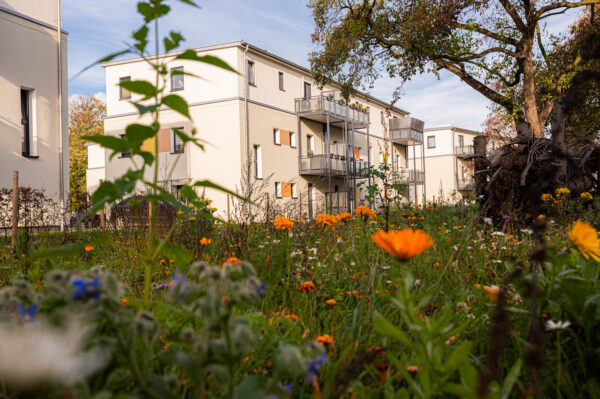Protecting Biodiversity
Managing a large real estate portfolio means we have an impact on the local climate and ecological environment of our neighborhoods. These neighborhoods are located in urban areas. The value of green spaces and trees is especially high in these areas, and this offers huge potential for sustainable action. We want to exploit this potential – not least to improve the quality of living for our tenants.
Our portfolio today comprises around 18.4 million m2 of green space, more than 337 km of hedges and approx. 211,000 trees. The tasks associated with maintaining these areas are performed by our residential environment organization and select partner companies. Our residential environment organization, which is focused on the German portfolio, employs around 1,300 people. It is responsible for the typical maintenance of outdoor areas and implements larger gardening and landscaping projects.
The natural environment is changing: heatwaves, higher temperatures, storms and heavy rains are increasingly leading to vegetation damage and infrastructure outages. Monoculture agriculture and ground sealing are driving these developments. The result: a decrease in biodiversity and in the quality of the residential environment in the neighborhood.
We thus see it as our task to combine living quality in the residential environment in our neighborhoods with an ecological balance. Therefore, we strive to make our neighborhoods as resilient against negative climatic events as possible. With each of our measures, we are looking to find a balance between an ecologically valuable and an economically sensible solution that benefits the quality of the neighborhood.
Our Promise:
1. Minimizing surface sealing!
- No surface sealing in protected areas or areas with high levels of biodiversity
- Construction preferentially in brownfield rather greenfield areas
- Reduction of the use of concrete in open spaces to minimum possible and aim of using carbon-neutral concrete
- Use of seepage paving for all newly built parking spaces
2. Preserving and promoting biodiversity!
- Local risk assessment using species and woodland reports before all construction work
- Creating habitats for animals in urban areas
3. Securing and protecting existing woodlands!
- Using deadwood to create habitats
- Compensation and replacement planting for any removals in construction
- Planting of climate-resilient trees and shrubs
Data Collection and Anticipation
We assess risks in the early stages of construction projects. Here, too, we have an eye on biodiversity. We perform analyses and biodiversity reports for the existing flora and fauna before each new planned construction project. The purpose of these reports is to ensure that all of the animal and plant species in an area are protected and maintained during the rest of the process. We also determine the health and conservation value of existing trees through a woodland survey.
We consider ourselves a green residential real estate company. We want to have as low an impact on the environment and climate as possible, and create added value for their protection and balance. We use forward-looking plans to ensure that aspects such as maintenance and potential future changes in climatic conditions are taken into account.
Modular System for Ecological Neighborhood Development
With our decentralized organizational structure, we respond to the local requirements on case-by-case basis. We simultaneously employ standardized and quality-assured processes. We have documented these processes in a product manual, which includes a modular system for ecological neighborhood development. It sets out the framework for implementing structural-design measures in the neighborhoods.
For instance, the product manual contains 22 area-specific seed mixes for wildflower meadows, several climate-resistant trees (e. g. field maple, common hornbeam or tree-hazel) and shrubs, seepage paving for paths and parking lots, and different drainage systems for water management. We exclusively use FSC-certified timber for playground equipment and insect habitats. We include the expertise of our product suppliers and use their information regarding the carbon footprint and recyclability of their products in order to integrate the information into our building information modeling (BIM) in open space design.
Before adding a measure to our modular system for ecological neighborhood development, we perform a qualitative development process with experts from Naturschutzbund Deutschland e. V. (NABU), Germany’s largest association for biodiversity issues. Together, we investigate a number of projects, e. g, various habitat types and nesting boxes for insects, bats and endangered bird species (such as the common swift) or the vitalization of habitats in the water collected in retention basins. Following three years of joint development and investigation work, we achieved the maximum number of habitats that could be implemented in the housing industry in our pilot neighborhood in Weitmar, Bochum. We will now let this neighborhood develop for three to four years and then reexamine the flora and fauna in this area.
We also take the neighborhood criteria of the DGNB (German Sustainable Building Council) for biodiversity (ENV2.4) and water cycle systems (ENV2.2) into consideration and already meet these standards in a number of neighborhoods.
We actively involve our tenants in order to raise their awareness of ecological issues, e. g., by landscaping common areas to make them close to nature or setting aside spaces that can be used for urban gardening. We also include the design suggestions and ideas that our tenants provide us with. We launched a partnership with the non-profit organization Acker e. V. (previously known as Ackerdemia e. V.) in 2020. We support the “Gemüseakademie” project, which uses vacant land on the grounds of nurseries and primary schools to grow fruit and vegetables. This gives children a chance to find out about plants and gardening. We also use other projects like “Bohnenabenteuer” and “Ackerhelden” to make the residents of our neighborhoods more aware of biodiversity. We include articles about projects of this kind in our customer magazine “zuhause” on a regular basis. With the help of NABU, we have created an ecological nature trail around our headquarters in Bochum, which informs employees and visitors about the eco-friendly measures we are implementing in our residential environments.


